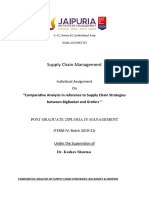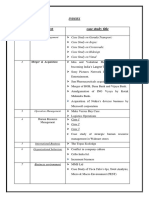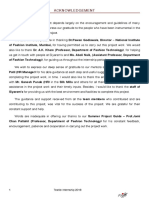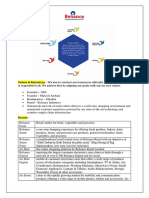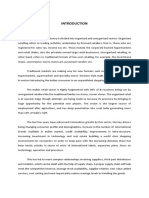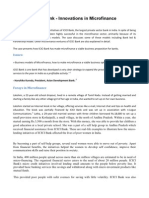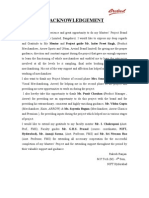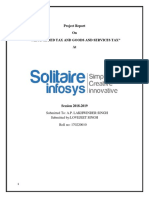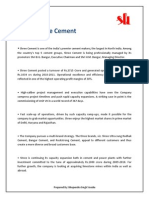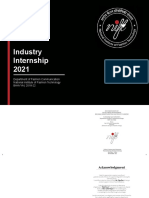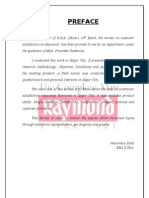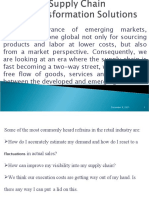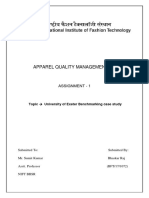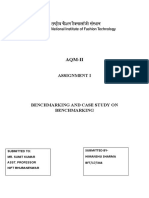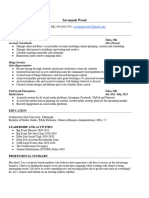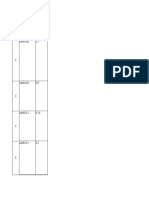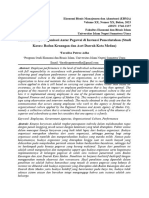Apparel Merchandising: Assignment-2
Apparel Merchandising: Assignment-2
Uploaded by
vibhavCopyright:
Available Formats
Apparel Merchandising: Assignment-2
Apparel Merchandising: Assignment-2
Uploaded by
vibhavOriginal Title
Copyright
Available Formats
Share this document
Did you find this document useful?
Is this content inappropriate?
Copyright:
Available Formats
Apparel Merchandising: Assignment-2
Apparel Merchandising: Assignment-2
Uploaded by
vibhavCopyright:
Available Formats
APPAREL MERCHANDISING
ASSIGNMENT-2
TOPIC- Research on RFID in Apparel Supply Chain, Trends
& their Applicability
Submitted to – Ms. Sulagna Saha
Asst. Prof
NIFT Bhubaneswar
Submitted by – Vibhav Sharnagat
Vidit Mishra
Yashaswini Raj
NATIONAL INSTITUTE OF FASHION TECHNOLOGY, BHUBANESWAR 1
CONTENTS
INTRODUCTION- RFID ............................................................................................................................. 3
WORKING OF RFID .................................................................................................................................. 4
Active RFID System- ............................................................................................................................ 5
Passive RFID system- ........................................................................................................................... 5
RFID TAGS CATEGORIES BASED ON THE RANGE OF FREQUENCIES ........................................................ 5
Low Frequency (LF) RFID ..................................................................................................................... 5
High Frequency (HF) RFID ................................................................................................................... 5
Ultra-High Frequency (UHF) RFID ....................................................................................................... 5
ISSUES FACED BY THE APPAREL INDUSTRY ............................................................................................. 6
SOLUTION THROUGH RFID IN GARMENT INDUSTRY .............................................................................. 6
RFID USED IN APPAREL SUPPLY CHAIN ................................................................................................... 7
WAREHOUSE MANAGEMENT / INVENTORY MANAGEMENT ................................................................. 8
RE-STOCKING ALERTS & REPLENISHMENT- ........................................................................................ 9
Automated stocking with RFID is making fast fashion even faster: ................................................. 10
BENEFITS OF USING RFID IN WAREHOUSE MANAGEMENT ................................................................. 12
TRACKING OF SAMPLES ........................................................................................................................ 13
PRODUCT DISTRIBUTION & OUTBOUND MANAGEMENT .................................................................... 13
FABRIC LOT STORAGE AND RETRIEVAL ................................................................................................. 14
TRACKING OF LABOUR MOVEMENT ..................................................................................................... 15
EMPLOYEE CARD- .............................................................................................................................. 15
JOB CARD- ......................................................................................................................................... 15
SUPERVISOR CARD OR MAINTENANCE CARD-.................................................................................. 15
RFID FOR PRODUCTION CONTROL ........................................................................................................ 16
Operator terminal – .......................................................................................................................... 16
Scanning RFID tag for production counting ...................................................................................... 16
Other kinds of transactions – ............................................................................................................ 16
ADVANTAGES OF USING RFID IN PRODUCTION CONTROL ................................................................... 17
REMOVAL OF AMBIGOUS DATA- ...................................................................................................... 17
IMPROVED VISIBILITY AND TRANSPARENCY- ................................................................................... 17
HELPS IN PROVIDING INCENTIVE SCHEMES- .................................................................................... 17
COST- EFFICIENCY - ........................................................................................................................... 17
RFID FOR WASHING DEPARTMENT....................................................................................................... 18
CUSTOMER - SPECIFIC SHOPPING REMINDERS AND PROMOTIONS .................................................... 18
USE OF RFID IN CUSTOMER RELATIONSHIP MANAGEMENT ................................................................ 19
NATIONAL INSTITUTE OF FASHION TECHNOLOGY, BHUBANESWAR 2
SUSTANIBALITY THROUGH RFID IMPLEMENTATION ............................................................................ 19
RFID FOR APPAREL RENTAL SERVICES................................................................................................... 20
RFID FOR BRAND SEGREGATION........................................................................................................... 21
CONTROL OF APPAREL GRAY MARKET ................................................................................................. 21
MERCHANDISE LEVELING ACROSS FASHION RETAIL STORES ............................................................... 22
CONCLUSION......................................................................................................................................... 24
FUTURE TRENDS OF RFID IN APPAREL INDUSTRY................................................................................. 25
REFERENCES .......................................................................................................................................... 26
CONTENT TABLE FOR FIGURE
Fig.1: RFID Tag Image .............................................................................................................................. 4
Fig.2: Working of RFID Tag ...................................................................................................................... 4
Fig. 3: Places where RFID Is Use In Supply Chain .................................................................................... 7
Fig. 4: Working of RFID in Warehouse Management ............................................................................. 8
Fig. 5: RFID Notification for Re-stock ...................................................................................................... 9
Fig. 6 RFID tag on Zara Apparel ............................................................................................................. 10
Fig. 7: RFID Tag Can Help For Distinguish Authentic Product & Knock Offs ......................................... 11
Fig. 8: RFID connected handheld device display necessary Information.............................................. 11
Fig. 9: Working of RFID reader and data transfer ................................................................................. 12
Fig.10: RFID tag attached with the proto sample ................................................................................. 13
Fig. 11: RFID use in Product Distribution channel ................................................................................ 14
Fig. 12: RFID keeping track of workers ................................................................................................. 15
Fig. 13: Use of RFID in CRM................................................................................................................... 19
Fig. 14: RFID showing Stock for different brand ................................................................................... 21
Fig.15: RFID chip can working with reader ........................................................................................... 22
Fig.16: RFID chip can access by Mobile ................................................................................................ 24
NATIONAL INSTITUTE OF FASHION TECHNOLOGY, BHUBANESWAR 3
INTRODUCTION- RFID
RFID takes auto-ID technology to the next level by allowing tags to be read without
line of sight and, depending on the type of RFID, having a read range between a few
centimetres to over 20+ meters. An RFID tag consists of a tiny radio transponder; a
radio receiver and transmitter. When triggered by an electromagnetic interrogation
pulse from a nearby RFID reader device, the tag transmits digital data, usually an
identifying inventory number, back to the reader.
Fig.1: RFID Tag Image
WORKING OF RFID
RFID belongs to a group of technologies referred to as Automatic Identification and
Data Capture (AIDC). AIDC methods automatically identify objects, collect data about
them, and enter those data directly into computer systems with little or no human
intervention. RFID systems consist of three components: an RFID tag or smart label,
an RFID reader, and an antenna. RFID tags or labels are embedded with a transmitter
and a receiver.
Fig.2: Working of RFID Tag
The RFID component on the tags have two parts: a microchip that stores and
processes information, and an antenna to receive and transmit a signal. The tag
NATIONAL INSTITUTE OF FASHION TECHNOLOGY, BHUBANESWAR 4
contains the specific serial number for one specific object. To read the information
encoded on a tag, a two-way radio transmitter-receiver called an interrogator or reader
emits a signal to the tag using an antenna. The tag responds with the information
written in its memory bank. The interrogator will then transmit the read results to an
RFID computer program. There are two types of RFID tags: passive and battery
powered. A passive RFID tag will use the interrogator’s radio wave energy to relay its
stored information back to the interrogator. A batter powered RFID tag is embedded
with a small battery that powers the relay of information.
TYPES OF RFID SYSTEMS
Active RFID System-These are systems where the tag has its own power
source like any external power supply unit or a battery. The only constraint being
the life time of the power devices. These systems can be used for larger distances
and to track high value goods like vehicles.
Passive RFID system- These are systems where the tag gets power through
the transfer of power from a reader antenna to the tag antenna. They are used for
short range transmission.
RFID TAGS CATEGORIES BASED ON THE RANGE OF
FREQUENCIES
Low Frequency (LF) RFID
These RFID systems operate in the 30 KHz to 300 KHz range, and have a read range
of up to 10 cm. While they have a shorter read range and slower data read rate than
other technologies they perform better in the presence of metal or liquids. LF tags are
used in access control, livestock tracking, and other applications where a short read
range is acceptable.
High Frequency (HF) RFID
HF systems operate in the 3 MHz to 30 MHz range and provide reading distances of
10 cm to 1 m. Common applications include electronic ticketing and payment and data
transfer. Smart card and proximity card payment and security systems also use HF
technology.
Ultra-High Frequency (UHF) RFID
These systems have a frequency range between 300 MHz and 3 GHz, offer read
ranges up to 12 m, and have faster data transfer rates. UHF tags are much cheaper
to manufacture, and as such are commonly used in retail inventory tracking,
pharmaceutical anti-counterfeiting, and other applications where large volumes of tags
are required.
NATIONAL INSTITUTE OF FASHION TECHNOLOGY, BHUBANESWAR 5
ISSUES FACED BY THE APPAREL INDUSTRY
A lack of internal and external transparency in the supply chain management due to
the presence of overseas operations is prevalent throughout the apparel
industry. Stemming from these points, a few key issues currently faced by the apparel
industry include:
Poor inventory management
Missing Cut panels
Reduced supply chain visibility
Extended checkout period
Delay in Real time data
Counterfeiting
Difficulty in tracking Labour Movement
SOLUTION THROUGH RFID IN GARMENT INDUSTRY
In the field of Apparel, the RFID is used in manufacturing, inventory control,
warehousing, distribution, logistics, automatic object tracking and supply chain
management. For example, the finished garments, different pattern pieces and
accessories can be traced and the progress of the production process can be
monitored.
The success and growth of an apparel manufacturing business depend on how well
cross-department production information is delivered, handled and executed in real-
time; what is required is a reliable platform to fulfil all these aspects of the business.
RFID (Radio-frequency identification) technology is the call of the hour to improve the
operational flow in such a complex environment of apparel production business. It
collects and analyses production data during the entire production workflow on a real-
time basis. This specifically deals with common production problems encountered on
the shop floor. It is used for product tracking, tracking labour movement, verifying the
production output, quality control, checking inventories of different stores in the retail
chain.
RFID system not only obtain information about production quantities in real-time
basis but also system tracks the efficiency of each line, tracks the performance of each
sewing machine and each worker. Most importantly it detects the source of the
problem in real-time. It shows who is working in which bundle, fast resolution of
bottlenecks and rapid tracing of quality issues to their source.
NATIONAL INSTITUTE OF FASHION TECHNOLOGY, BHUBANESWAR 6
RFID USED IN APPAREL SUPPLY CHAIN
Fig. 3: Places where RFID Is Use In Supply Chain
1.Raw 4.Checking
2.RFID tag 3.Warehouse 5.Logistic to
Material out of
fixed checking in the Customer
Checking In warehouse
6.Retailling 10.Check out
store checking 7.Sorting out 8.Displaying 9.POS the retalling
in Store
NATIONAL INSTITUTE OF FASHION TECHNOLOGY, BHUBANESWAR 7
WAREHOUSE MANAGEMENT / INVENTORY
MANAGEMENT
Since, RFID technology can simultaneously identify the characteristics of multiple tags
in the case of non-contact non-visible, that is, dozens of pieces of clothing with
electronic tag-attached clothing can accurately read all the logistics data at one time
through the RFID reader, greatly improving the efficiency of logistics. If RFID
technology is used in the management of the inbound and outbound warehouse, the
logistics management of the logistics distribution centre, and the storage management
of the retail store, the entire supply chain of “shop replenishment demand---distribution
centre---manufacturer” can be realized, leading to optimal management of the
process.
In apparel Industries, when the garments are processed from the factory for
processing, the staff puts the goods on a forklift and sends them to the back-end
warehouse. If necessary, a reader and antenna is installed on each forklift to identify
the RFID tag data. When the forklift takes the goods to the warehouse, it is read by
the reader at the door of the warehouse and it sends the label information to the
warehouse. RFID helps to manage the system and record the details of the receipt of
the goods. In the warehouse, the goods are placed on the container according to their
type, such as style or brand. The shelves are labelled with a barcode for identification.
On a daily basis, employees will hold RFID cameras to read the goods labels and
shelf barcodes, and link the goods to the stored shelves. The barcode scanner is
embedded in the handheld. The container uses barcodes instead of RFID tags to avoid
simultaneous acquisition.
Fig. 4: Working of RFID in Warehouse Management
The use of RFID technology in warehouse management enables visual
management of all management units, which can greatly shorten packaging, handling,
inventory, and statistical time, thereby reducing cargo damage, accelerating capital
turnover, and greatly improving warehouse management efficiency. Through this
NATIONAL INSTITUTE OF FASHION TECHNOLOGY, BHUBANESWAR 8
process, 15,000 garment items can be verified per hour in only one RFID channel.
Automating the verification process can reduce the time it takes to spend on a supply
chain by 5 to 7 days.
RE-STOCKING ALERTS & REPLENISHMENT- Products are monitored to
ensure that they remain stocked at appropriate levels. When they fall below that level,
an alert is sent to the stockroom or office to bring out or order more merchandise. For
stores with stockrooms, RFID monitoring alerts employees when stock levels reach
the threshold. Depending on how the system is configured, re-orders may be done
automatically for items that the store plans to continue selling. For example, if many
black trousers of waist 32-size are being sold and are getting out of stock, RFID can
Automated store floor replenishment can be enabled using
RFID tags, and integrating POS to the backend inventory system. Based on items
sold at the POS, businesses can have accurate, near-real-time intelligence into
inventory records, and locate items in a facility at all times. Adopting item-level RFID
can prevent inventory distortion and loss of sales, increase inventory accuracy up to
99% and maintain it at 95-99%. This level of accuracy enables retailers to increase
on-floor availability by up to 30% and successfully implement Omni-Channel
strategies. With RFID, inventory counting can be done faster, more frequently and with
greater accuracy, leading to significant reductions in out-of-stocks and improved
revenue and gross margin. Send an alarm to order more such trousers from the
storeroom.
Fig. 5: RFID Notification for Re-stock
NATIONAL INSTITUTE OF FASHION TECHNOLOGY, BHUBANESWAR 9
Automated stocking with RFID is making fast fashion even faster:
Zara’s RFID system encodes each garment on the manufacturing floor, allowing for
the highly targeted tracking of item sales, stocking, and availability. Each time a
garment is sold off the rack, Zara’s system prompts the stock room to send another
item out to the floor. The granularity allows online window shoppers to check if an item
is in stock at a local store before making a purchase. Tagging their clothing with RFID
permits staff to know exactly where garments are in their stock room and to control
what and when to re-stock. Not only does the stockroom get notified of exactly what
products to restock when something is purchased, stock controllers can also do
inventory in less than a sixth of the time it used to take. Having this degree of control
of stock means knowing exactly what needs to be produced or ordered to replenish,
without overshooting and overspending.
The ease of scanning RFID tags also makes stores more efficient: Zara reports that
associates who used to spend 40 hours per store scanning barcodes can now use
RFID-reading guns to log inventory in closer to just 5 hours.
Fig. 6 RFID tag on Zara Apparel
Other brands like Italian-French luxury label Moncler, for example, outfits its products
with RFID chips that customers can authenticate via an app or website — creating a
tangible way to distinguish Moncler goods from knock-offs. Brands like Benetton and
Salvatore Ferragamo have pursued similar programs. Brand like MemoMi use the
RFID tag for display the product information on their smart screen to display all the
available colour and sizes.
NATIONAL INSTITUTE OF FASHION TECHNOLOGY, BHUBANESWAR 10
Fig. 7: RFID Tag Can Help For Distinguish Authentic Product & Knock Offs
Brand like lulu lemon RFID technology revolves around the customer experience. The
retailer realized that merchandise was left sitting in the warehouse instead of on the
sales floor. However, the company’s inventory accuracy improved to 98% because of
the RFID implementation. Employees are now equipped with handheld devices and
an app that allows them to check inventory without having to leave the customer’s
side.
SMART INVENTORY
Use RFID reader to carry out warehouse
inventory , thus ensuring the balance of
inventory, and timely replenishment, to
avoid the phenomenon that a certain
clothing in the clothing store is out of
stock or broken code, to ensure the
normal needs of customers.
Fig. 8: RFID connected handheld device display necessary Information
NATIONAL INSTITUTE OF FASHION TECHNOLOGY, BHUBANESWAR 11
BENEFITS OF USING RFID IN WAREHOUSE
MANAGEMENT
The major advantage is automation of identification process, elimination of manual
work to scan items and continuous updating of data.
The use of RFID provides comprehensive visibility throughout the entire supply
chain.
The tagged items that are moving around the business can be monitored from
supplier warehouse to the shelves. This comprehensive view of the supply chain
allows the industries to trim inventory, streamline logistics, and optimize the
efficiency of their workforces hence gaining competitive advantages over other
industries.
Efficiency improvements in loading and unloading of cargo can be reached, since
warehouse operators do not need to manipulate optical readers to collect data
about the products that are being loaded or unloaded.
RFID tags are read via radio frequencies therefore it is not mandatory to place the
items in a particular position to read it. This could be helpful for effective warehouse
management.
the RFID-tagged products allow stores to track locations and count inventories in
real time. This will help to monitor products in a better way, for certain products to
prevent out-of- stock situation. It also removes the stagnant stocks of apparels
present at any given point of time.
It helps to reduce the labour costs and improves customer satisfaction by ensuring
right products reach right customers at the right time.
It helps to combat with the problem of counterfeiting of products inside the
warehouse as well as the retail store of the fashion industry; hence preventing retail
shrinkage.
Fig. 9: Working of RFID reader and data transfer
NATIONAL INSTITUTE OF FASHION TECHNOLOGY, BHUBANESWAR 12
TRACKING OF SAMPLES
Many industries these days are also inserting RFID tags in their samples to better
control their precious prototypes. When fashion companies scale to the point that they
begin lending samples across the globe for different editorials or events, there is a
high risk of losing these items. There are sample-tracking platforms, which use RFID
tags to control exactly which products have left the showroom, where they are, if they
are on their way back to the studio or if they have been misplaced. Because of this
innovation of putting RFID chips in the samples, the fashion companies have
reportedly experienced an 85% reduction in sample loss.
Fig.10: RFID tag attached with the proto sample
PRODUCT DISTRIBUTION & OUTBOUND MANAGEMENT
The products are delivered in cartons or as hanger-goods as ordered by the stores,
and transported without storage at the logistics service provider. The distribution
centre staff equipped the goods with Serial Shipping Container Code (SSCC) tags and
brought them to the outgoing goods area. At the warehouse entrance of distribution
centre, RFID readers track the merchandise as it came in delivered products are
registered, distinguishing stackable and hanger goods. The data stored on the RFID
transponders are read automatically for each individual product.
Before the RFID technology was considered, the clothing distribution process
was handled manually. That is to say, when the garments arrive at the distribution
centre from the manufacturer, the staff must manually check them one by one, and
when the garments are sent to the clothing store, they are also packaged one by one
and manually recorded information, resulting in many errors. After using the RFID
application, the manufacturer's label is posted on the item to be sent and verified prior
to delivery, after which an advance shipping notice is issued to the retailer. After the
packaged garment arrives at the distribution centre, it will be placed on the conveyor
belt. During the delivery process, the packaged garments will be read by the channel
NATIONAL INSTITUTE OF FASHION TECHNOLOGY, BHUBANESWAR 13
RFID reader, and the data after reading will be transmitted to the system. The software
will confirm the ID information. If the system is incorrect or missing, a warning will be
issued to remind the employee to inspect the clothing in the box. After the garment is
repackaged, it is shipped to the clothing store. Before loading the truck, the staff will
read the ID number on the label in the RFID channel according to the packing list, and
finally send the advance shipping notice to the clothing store.
Fig. 11: RFID use in Product Distribution channel
FABRIC LOT STORAGE AND RETRIEVAL
Due to limited machine capacity in a wet processing unit, a fabric order may require
many number of lots, each lot will be having their own shades. In this process, it is
mandatory to bring each lot up to the garment stitching process in order to control the
shade variations and product mix up. Applied RFID tags on the fabric lot as a part of
a new system will help to control production units and stock-rooms. The tags are
attached to the outside parts of cores of rolls with fabric. This has several advantages.
First, the process of fabric stock-taking in stockrooms is much more effective.
Secondly, the effectiveness of all production and storage processes is higher.
Moreover, it enables tracking a given object at every stage of its production process.
NATIONAL INSTITUTE OF FASHION TECHNOLOGY, BHUBANESWAR 14
TRACKING OF LABOUR MOVEMENT
Knowing where an employee is at a particular time would allow the management to
dispatch the closest-qualified employee to a location requiring assistance. If an RFID
reader detects an RFID-tagged employee approaching a security door, the door could
be designed to open automatically. This would allow employees carrying garment
packages or bundles to move more efficiently. Additionally, if store management could
verify through an automated system that an employee was at the appropriate station
at the start of the shift or end of a break, some aspects of labour management could
be automated, requiring less effort by employees and the management. This type of
monitoring would also allow the management to know, for instance, if an employee
spends excessive time in the break room or if he/she is not getting enough break time.
Reports could be generated automatically to flag exceptions for management
attention.
EMPLOYEE CARD- Employee cards are issued to operators and checkers. The
operator uses an employee card to sign on at his/her workstation. If an operator does
not scan the employee card system keeps it keeps them absent for the day. One more
important thing, without scanning the employee card; operator would not be able to
scan bundle cards at his/her terminal.
JOB CARD- Job cards used to assign jobs at the terminals. Job cards are also used
for special purposes. Normally, each terminal is pre-set with the operation/job that
would be performed by the operator. There may be possibility that operator had to do
multiple jobs. In that situation, operators use job card to change the operation in the
terminal. Jobs cards are labelled with job name and number. The operator scans the
job card of the job that will be performed by the operator, made possible through the
application of RFID chips on the job-cards.
SUPERVISOR CARD OR MAINTENANCE CARD- This system of using
RFID has an option to record off-standard work and lost time. To authenticate those
lost time approvals by supervisors or assigned person is needed. Also when machine
breakdown is reported by the operator and the issue is solved by the maintenance,
they scan their card to stop the lost time request.
Fig. 12: RFID keeping track of workers
NATIONAL INSTITUTE OF FASHION TECHNOLOGY, BHUBANESWAR 15
RFID FOR PRODUCTION CONTROL
Attaching tags to bundle – one can attach a RFID tag to each bundle before loading it
to the employee. The RFID tag can be attached to a bundle in the cutting section or
one can attach to the bundle in the feeding area. Bundle/piece can be loaded in many
ways into the line. All the kind of bundle movements can be adopted by RFID tags
assignment and operator terminal profile. Following are some of the ways in which
bundles are loaded into the lines-
1) Moving bundle throughout the line.
2) Moving a single piece throughout the line.
3) Feeding bundle in preparatory section but move a single piece in the assembly
section.
4) Loading bundle to all operation but want to count pieces one by one.
5) Loading different bundle components at different places at the same time -
parallel loading.
Operator terminal – The operator terminal is set up with the operation code
and it is made for scanning tags. Operators login to the system by entering their
employee code into their terminals. Once they login to a terminal, all kinds of
transactions processed into the terminal, are recorded against the employee.
Scanning RFID tag for production counting – Before an operator starts
working on a bundle, they scan RFID to the sewing terminal. Once garment
bundles reach to the operators, they scan the RFID tag to their terminal. System
captures all the transactions performed at the operator’s device. The system
captures their transaction and bundle quantity as production quantity.
Other kinds of transactions – Other than scanning bundle tags there many
other different transaction operators can do as per their needs and data required
by the factory. Like, the operator can split the bundle, they can log-out from one
workstation and work another workstation by login to another terminal. If they work
for multiple operations, they can change the operation in the terminal. In case an
operator gets the whole lay and do the continuous work, scanning of individual
bundles can be avoided, by using bulk operation function.
The operator sees their production, earning and performance in the terminal. The
operator can send an off-standard request to line supervisor by entering off-
standard code in her terminal. A supervisor can approve the off-standard code
required on the terminal or from the compute.
NATIONAL INSTITUTE OF FASHION TECHNOLOGY, BHUBANESWAR 16
ADVANTAGES OF USING RFID IN PRODUCTION
CONTROL
REMOVAL OF AMBIGOUS DATA- With the use of RFID in production
system, data recorder and line supervisor cannot give inaccurate production data.
As operator, get RFID tag for the garment, she/ he stitches. Manual data collection
and report making can be eliminated by installing a real-time production tracking
system. All production data, lost time data and quality data will be captured from
the operator’s device and the system will process those data and report will be
made automatically in the pre-fined report templates; thereby removing any
ambiguity in the data collection.
IMPROVED VISIBILITY AND TRANSPARENCY- One can view
production data from a remote having internet connection. Managers can review
data for all sections and lines. They can compare performance between the lines.
They can track order status, WIP. Some of the common reports that factories can
easily get with the installation of RFID in their production systems are as follows-
1) Hourly production report
2) Line wise employee attendance and absenteeism
3) Previous day's employee wise production, operation wise production
4) Today's line efficiency and previous day's line efficiency
5) WIP report
6) Individual operator's efficiency and skill history
HELPS IN PROVIDING INCENTIVE SCHEMES- With real-time
production tracking system, one can introduce an incentive scheme for sewing
operators. As, incentive scheme is the main driving force for productivity
improvement in the shop floor. For designing an incentive scheme, one would need
production and efficiency for individual employees. With the real-time production
tracking system, one will have all the basic data that one needs for incentive
scheme and calculating employee’s bonus amount.
COST- EFFICIENCY - RFID tags are reused until the tag get damaged. Even
one tag can be used for more than 10 years. So, no expenses in RFID tag. It is a
time-saving tool for industrial engineers. In a garment factory, IEs spend a lot of
time in daily report preparation and data analysis. Data preparation can be
eliminated by introducing the RFID system, which is going to be economically
viable for the company.
NATIONAL INSTITUTE OF FASHION TECHNOLOGY, BHUBANESWAR 17
RFID FOR WASHING DEPARTMENT
It is extremely important to make a garment go through washing/laundry department.
It is done to remove dirt, spots, oil stains that accumulate to the garment at
the garment manufacturing processes. The laundering process is usually facilitated by
2-8 people at different laundry chutes, and employees may spend hours sorting
through laundry.
With an RFID laundry management system, RFID tags are attached to each piece
of laundry, and when the RFID tags move through the assembly line, an RFID
reader sends an interrogating signal and reads the tags. When each tag is read, the
software determines what type of textile is being read, and directs it to the proper area
or machine. The software’s findings can be displayed on a screen so that a person
can immediately direct the fabric or garment to its next destination.
The use of RFID provides accurate wash count records. The laundry wash cycle
per garment is an important metric, as wash cycle analytics help predict the end-of-life
date for the garment. Most linens or uniforms can only withstand a certain number of
high-powered wash cycles before they start to wear and fray. It becomes difficult to
estimate a garment’s end-of-life date with no records of wash cycle counts, which
makes it hard to plan for the reordering of replacements. When garments or linens are
released from the washing machines, RFID readers detect the RFID tags sewn into
the fabric. Next, the wash cycle count will be updated in the software database. When
the software detects that a garment or linen is nearing its end-of-life date, the software
can prompt users to reorder that type of garment or linen. This process ensures that
the company always has stock of each garment or linen needed, therefore reducing
lag time if one is lost or destroyed.
CUSTOMER - SPECIFIC SHOPPING REMINDERS AND
PROMOTIONS
With RFID on loyalty cards to identify the customer, and a customer shopping-history
database, items could be priced differently depending on the characteristics of the
shopper (e.g., special promotions for first-time shoppers and rewards for frequent
shoppers). Different promotions could be offered to different customers via their
personal digital assistants or cell phone displays, at kiosks (Information Booth), and
by employees receiving prompts on their point-of-sale terminals. Additionally, if
customers have submitted their profiles to the store, they could be reminded of
upcoming events such as birthdays, and have purchases suggested to them.
These can be added on to the loyalty cards which already exist at places like
Shopper’s Stop, Wills Lifestyle, etc., and it can be centralised to all the stores in
different cities so that customers get similar welcome whether they are in Bangalore
or Mumbai or Delhi or any other place of our country.
NATIONAL INSTITUTE OF FASHION TECHNOLOGY, BHUBANESWAR 18
USE OF RFID IN CUSTOMER RELATIONSHIP
MANAGEMENT
It is quite imperative to understand the needs and taste of customers especially in
fashion industry to offer them the right product of their match. As competition is intense
between the brands so it is important to satisfy the customers by knowing their choice
by creating their history of purchases, especially for high-end products. By creating
their profile, age group, choice trend, preferred styles etc. the professional suggestion
can be provided upon their next purchase so that they feel taken care of. The
significance of using RFID is to be in constant contact with VIP customers, even if the
staff member quits their job. As customer’s preferences are different so are their
buying behaviours and patterns, RFID can be used to interact product with the
consumer to suit their choices and assist them making purchase decision.
Subsequently the customers can be offered customized assistance to cater to their
choices thus increasing the revenue. Intelligent Clothes Racks are equipped with an
RFID antenna. The moment an article is returned, is also registered.
The time that lapsed before a customer returned an item to the rack, provides valuable
information: If a customer put a blouse back on the clothes rack after five seconds,
she possibly did not like the material. If five minutes went by, it is likely that the
customer tried on the article. Smart Shelves offers similar functionalities for stacked
goods. RFID tags can help retailers track the customer’s shopping behaviour to
identify why an item is not selling well. For example, if RFID data indicates that the
item is taken to the fitting room but not converted to sale, the problem could be with
the fit.
Fig. 13: Use of RFID in CRM
SUSTANIBALITY THROUGH RFID IMPLEMENTATION
Use of RFID technology has dramatically improved the efficiency, accuracy, and safety
of fiber recycling. RFID technology in recycling facilities can help identify where a
garment comes from, what material it consists of, and the journey it took through its
supply chain. Certain ingredients in garments such as plastics and metals make it
harder to recycle their fiber; furthermore, recycling is not always feasible due to the
NATIONAL INSTITUTE OF FASHION TECHNOLOGY, BHUBANESWAR 19
issues in separating dyes and the different polymers used in the garment’s original
fiber. By introduction of RFID to the recycling process, it will be easier to identify which
polymers are used in each garment and, by doing this, it will effectively simplify the
recycling process such that unnecessary time and resources are not wasted in trying
to recycle what is not recyclable. Furthermore, it is known that passive UHF (Ultrahigh
Frequency) RFID tags have the ability to let the readers track the route of the garment
through mobile platforms.
This can make recycling of garments more accessible by helping recycling facilities
easily gauge the location of relevant items through an easy to use platform. It can also
potentially show consumers where their recycled garments are going to by having the
platform trace the path that each of the consumer’s garment goes through from
garment to fiber to garment. By making recycling of fiber more efficient, it effectively
increases the number of garments that gets recycled, and this is significant because
of the high prices of recycling processes are what keeps many potential investors from
investing in textile recycling. Fiber recycling is important to the environment because
energy savings of recycled fiber versus virgin can be as high as 53%, while the water
savings can be even 99% and the corresponding chemical saving can be 88%. RFID
can improve the efficiency of fiber recycling and more recycled fiber can be used in
apparel garments, and if this occurs, the above environmental savings can be
achieved.
RFID FOR APPAREL RENTAL SERVICES
Loaning or renting textiles can be complex unless the company installs a concise
method to maintain information such as loan date, due date, customer information,
and linen information. An RFID system with software can provide a custom database
that not only stores the important information, but also prompts the company when the
due date is nearing. A system with this capability allows companies to communicate
approximate back-in-stock dates to their customers. Providing customers with
approximate instead of hypothetical return dates improves customer relations and, in
turn, improves textile rentals by removing unnecessary hassle. Companies that rent
textiles have the unique opportunity to learn about their customers through the RFID
tags on the rented textiles. Sewing RFID tags into textiles helps document information
such as previous renter, rent date, and rent duration. Keeping these records can help
the company understand item popularity, item history, and customer preferences.
NATIONAL INSTITUTE OF FASHION TECHNOLOGY, BHUBANESWAR 20
RFID FOR BRAND SEGREGATION
It is quite beneficial to adopt RFID system for fashion retail stores, which stocks a
range of products and brands under one. The different brands can be controlled in
terms of their inventory and location quite easily using RFID whereas it would be quite
challenging task to segregate the brands in case they are mixed. RFID also reduces
the human error as this technology is least human dependent when monitoring the
inventory level, brand identification and product authenticity.
Radio frequency identification can also be used to avoid illegal product alteration
to grey market and increasing product security and to give information about shopping
behaviour of customer at retail. Having all these issues solved, textile and fashion
supply chain can be made more streamlined and efficient in terms of cost and
performance.
Fig. 14: RFID showing Stock for different brand
CONTROL OF APPAREL GRAY MARKET
Gray market is the flow of goods through channels other than those authorized. In
2017, the parallel import market reached €17 billion, and it is estimated that it will reach
36 billion by 2022. In addition, gray market may also pose a risk to the health of the
consumer since counterfeit products are manufactured by circumventing the rules
aimed at safeguarding the safety and health of consumers and are not subject to
controls by the competent authorities.
In particular, companies have begun to insert, within their articles, chip labels, in
which are stored a whole series of information on the origin, the composition and the
shipping route of each individual product. This information is added to the data on size,
colour, and model. This allows fashion brands to verify, at any time, the authenticity of
the products, by subjecting them to scanning, but also to monitor their traceability
NATIONAL INSTITUTE OF FASHION TECHNOLOGY, BHUBANESWAR 21
along the entire supply chain and in the event of intercepting any anomalies that may
arise.
Fig.15: RFID chip can working with reader
MERCHANDISE LEVELING ACROSS FASHION RETAIL
STORES
By monitoring inventories at different stores within a retail chain, the management will
make an intelligent decision about how to meet customer demand and reduce
discounting by shipping items between stores. For example, Delhi will have a longer
season for selling sweaters than Bangalore. If, in February, Bangalore stores are
oversupplied for what remains of their season, while sweaters are still selling well in
Delhi, they may decide that enough discounting would be eliminated to justify the cost
of shipping items from Bangalore to Delhi.
RFID could be used to track inventories and indicate when the sweaters actually
reached the Delhi store so that Delhi would not be billed for them until it received the
merchandise.
Some stores require customers to leave merchandise that they are carrying at a desk
or provide evidence of purchase. However, if a store has RFID readers or writers and
RFID-tagged merchandise, shoppers could avoid this step. Instead, at checkout, the
readers would charge customers only for items with tags that indicate that they were
not already paid for. The theft of garments from the fitting room can be prevented by
mounting a small reader at the entry point of the room. The tag information of the
garment is captured when the customer takes the garment to the fitting room. The
items that are taken to the fitting room but not come out are reported as potential loss
NATIONAL INSTITUTE OF FASHION TECHNOLOGY, BHUBANESWAR 22
items. So the RFID can be used to identify the missing merchandise and prosecution
of the shoplifters
For example, at Burberry retail stores, RFID tags are present in products in their
“500 stores spread across 50 countries which can communicate with shoppers’
mobiles, giving information about how items were produced or recommendations on
how they can be worn or used”. Also, in flagship store of Ralph Lauren in Manhattan
if we take an item into the fitting room then their RFID technology identifies the item
present in our hands. It then provides you with a list of the available colours and sizes
on a screen, answering all the questions before they are even asked, also it removes
the possibility of hiring salesperson to guide people, because RFID these days provide
people with personalized experience of shopping according to their demands.
Another example of fashion brand using RFID to provide consumers with hassle-
free experience of apparel shopping is Rebecca Minkoff’s. In 2019, luxury fashion
retailer Rebecca Minkoff launched a collection of 10 limited-edition smart handbags in
time for spring. Each “connected” bag comes equipped with a RFID-enabled hand-tag
that qualifies the owner for the company’s loyalty program and unlocks exclusive perks
like private styling sessions, style recommendations, video content, and an invitation
to the brand’s next fashion show. Given that a handbag naturally travels with its owner,
the company hopes to expand on the rewards it offers customers to third parties as an
incentive to wear it out more and inevitably drive brand loyalty. RFID can improve the
checkout time. Customers waiting in line can get extremely impatient. RFID devices
can work even at a few feet from the scanner; if a bag full of purchased items comes
under the scanner, it queries all the RFID devices and totals the purchases
immediately. Checkout times can thus be improved over 40% using RFID. Delighted
customers drive repeat business and will surely buy more from an RFID enabled
customer, as opposed to a regular retailer. The ease of the process also encourages
customers to increase their cart size, thereby enabling retailers to achieve top-line
growth.
It uses RFID to bring customers a stress-free shopping experience in which waiting
in long lines to pay is no longer necessary. The store is outfitted with RFID tables and
iPads; one has to simply place the item to purchase on the table, the technology
identifies the apparel item and the consumers pay for it via the iPad. RFID can improve
the checkout time. Customers waiting in line can get extremely impatient. RFID
devices can work even at a few feet from the scanner; if a bag full of purchased items
comes under the scanner, it queries all the RFID devices and totals the purchases
immediately. Checkout times can thus be improved over 40% using RFID. Delighted
customers drive repeat business and will surely buy more from an RFID enabled
customer, as opposed to a regular retailer. The ease of the process also encourages
NATIONAL INSTITUTE OF FASHION TECHNOLOGY, BHUBANESWAR 23
customers to increase their cart size, thereby enabling retailers to achieve top-line
growth.
Fig.16: RFID chip can access by Mobile
CONCLUSION
The use of RFID systems in apparel industry is rapidly increasing. In future almost all
the manufacturers, distributors and retailers in textile and apparel business will be
using the RFID system. Although, RFID systems cannot completely replace the
barcode technology, due to higher cost but the accuracy, speed and the return on
investment is high in RFID system. RFID system is a promising technology, which will
become ubiquitous in the future helping organizations to solve problems in supply
chain management, security, personal identification and object tracking. The basic of
success lies in understanding the technology and other features to minimize the
potential problems. It is high time that the apparel industries should start utilizing the
RFID technology in various applications such as manufacturing, storing purposes.
NATIONAL INSTITUTE OF FASHION TECHNOLOGY, BHUBANESWAR 24
FUTURE TRENDS OF RFID IN APPAREL INDUSTRY
The apparel industry is characterized by short product life cycle, frequent style
changes, a wide range of product designs and hence input materials; variable
production volumes; high competitiveness and often high demand on product quality.
In addition to these challenges, the use of RFID increases the cost and maintaining
privacy creates extra challenges. The organizations dealing with textile and apparel
products should start with the tracking of expensive goods as the reduction in the lab
or and theft of these items can compensate the cost of these items. RFID has
advantages in speed, accuracy and convenient over traditional barcode systems.
Therefore, in the future, RFID tagging will gradually replace traditional barcode
systems and facilitate supply chain and inventory management.
Important technical challenges still need to be resolved for fully successful operation
of RFID in apparel manufacturing. We will increasingly see how RFID technology can
extend the ability of computers in combination with internet to sense and respond to
the physical world. In future, RFID will make computing an unobtrusive, intuitive part
of everyday life, as refreshing as a walk through the nature.
The largest challenge to the widespread use of RFID is the cost in apparel
manufacturing. These challenges can be reduced by increasing the volume of usage.
In addition, standardization and technological developments can help in reducing the
cost. RFID chips can be developed, which can work in different places for different
applications. These ideal RFID chips will require a frequency independent capability
and would be integrated with read/write memory. In addition, the software needs to be
customized to accommodate the number of different uses. Recently, all the
merchandise uses the barcodes for identification and at the point of sale, which are
easily printed and attached to the products within a very short period. However,
finalization of the design and preparation of RFID tags is time-consuming process.
It is clear that RFID technology has a very bright future in the textile and clothing
industry. New areas of applications will emerge by the technical advancements and
we will see more RFID applications in departments where they are currently not being
used.
NATIONAL INSTITUTE OF FASHION TECHNOLOGY, BHUBANESWAR 25
REFERENCES
https://rfid.net/where-is-rfid-used/use-rfid-retail-apparel
https://indiantextilejournal.com/articles/FAdetails.asp?id=2738
https://www.shopify.in/retail/5-examples-of-innovative-uses-for-rfid-
technology-in-retail
https://www.fibre2fashion.com/industry-article/7346/rfid-applications-in-textile-
and-apparel-industry
NATIONAL INSTITUTE OF FASHION TECHNOLOGY, BHUBANESWAR 26
You might also like
- Mas HoldingsDocument23 pagesMas HoldingsMihara MinsandiNo ratings yet
- OrginalDocument17 pagesOrginalPrithesh KumarNo ratings yet
- Indian Company ListDocument63 pagesIndian Company ListMuskan ThakurNo ratings yet
- Distribution Channel of CTMDocument21 pagesDistribution Channel of CTMChanchal BhagatNo ratings yet
- Swot Analysis of Aarong BangladeshDocument11 pagesSwot Analysis of Aarong BangladeshFarzana Khan0% (2)
- Bata Supply Chain 2Document10 pagesBata Supply Chain 2Sourav SarkarNo ratings yet
- 4.0 Industry in Supply ChainDocument18 pages4.0 Industry in Supply Chainvibhav100% (1)
- Raymond LimitedDocument24 pagesRaymond LimitedVinay Ramwani50% (2)
- Ruchi Ratan - Resume - NiftDocument1 pageRuchi Ratan - Resume - NiftKARISHMA RAJNo ratings yet
- PresentationDocument34 pagesPresentationSingh Sarita0% (1)
- Supply Chain Management - Pgfa1941Document9 pagesSupply Chain Management - Pgfa1941Ravina SinghNo ratings yet
- RM EditDocument48 pagesRM EditnikitaNo ratings yet
- RQ1E40A035 - Online Assignment 3 - MKT518 - 11911770 MKT 518 CA 3Document21 pagesRQ1E40A035 - Online Assignment 3 - MKT518 - 11911770 MKT 518 CA 3mayankNo ratings yet
- Retail Management Case StudyDocument81 pagesRetail Management Case StudyBabita Antil0% (1)
- Foreign Investment and Its Necessity: Introductory: Saroj K GhimireDocument28 pagesForeign Investment and Its Necessity: Introductory: Saroj K GhimireChandra Shekhar PantNo ratings yet
- Thesis Synopsis PrfoformaDocument12 pagesThesis Synopsis PrfoformaDr-Shyam PangaNo ratings yet
- Raymond SDocument9 pagesRaymond SGarima GargNo ratings yet
- Industrial Visit To Alok Industries LimitedDocument28 pagesIndustrial Visit To Alok Industries Limitedjyotika kushwahaNo ratings yet
- Summer Training ReportDocument44 pagesSummer Training Reportyash choudharyNo ratings yet
- Bajaj CapitalDocument15 pagesBajaj Capitalharshita khadayteNo ratings yet
- Green Supply Chain of WalmartDocument9 pagesGreen Supply Chain of WalmartkankhuaNo ratings yet
- Siyarams RoughDocument38 pagesSiyarams RoughASHISH BHUWANIANo ratings yet
- Polar Adidas Case Study The Most ImportantDocument5 pagesPolar Adidas Case Study The Most ImportantBlabla100% (1)
- Aspinwall Export & Import MBA ProjectDocument23 pagesAspinwall Export & Import MBA ProjectGopi KrishzNo ratings yet
- CRM DrishtyDocument35 pagesCRM DrishtyDrishty SharmaNo ratings yet
- Reliance RetailDocument2 pagesReliance RetailSahil AnandNo ratings yet
- Pantaloon MISDocument7 pagesPantaloon MISrajat_mahajan599400% (1)
- Analysis On Impact of Strategic HRM in Recruitment and Talent Management Process of British American Tobacco (BAT) .Document36 pagesAnalysis On Impact of Strategic HRM in Recruitment and Talent Management Process of British American Tobacco (BAT) .Muntasir haque FayezNo ratings yet
- Hrpolicy Bigbazar (HRPOLICY) MDocument30 pagesHrpolicy Bigbazar (HRPOLICY) MVineet AgarwalNo ratings yet
- ICICI Bank - Innovations in FinanceDocument3 pagesICICI Bank - Innovations in FinanceanuajnNo ratings yet
- A Study On Retention Stratagy at Raymond LimitedDocument83 pagesA Study On Retention Stratagy at Raymond LimitedY Narasimhulu100% (1)
- The Practice of Basic HR Functions in Garments Industry inDocument14 pagesThe Practice of Basic HR Functions in Garments Industry inMizanur Rahman EmonNo ratings yet
- Arvind MillsDocument111 pagesArvind Millsfun_madurai100% (3)
- Finance Project On Vat &GSTDocument89 pagesFinance Project On Vat &GSTLavi KambojNo ratings yet
- Project Report On Operations RetailDocument50 pagesProject Report On Operations RetailJimmy JaganiNo ratings yet
- Supply Chain Management: Nift, HyderabadDocument19 pagesSupply Chain Management: Nift, HyderabadvishuananthaNo ratings yet
- Supply Chain Circularity Practices of Snowtex Outerwear LTDDocument13 pagesSupply Chain Circularity Practices of Snowtex Outerwear LTDfaisal huqNo ratings yet
- Human Resources: Topics DiscussedDocument8 pagesHuman Resources: Topics DiscussedswatitikkuNo ratings yet
- Landmark Group Leading Retail Conglomerate in The Middle East & IndiaDocument25 pagesLandmark Group Leading Retail Conglomerate in The Middle East & IndiadurgakingerNo ratings yet
- About Shree CementDocument47 pagesAbout Shree CementkavitadabiNo ratings yet
- InTERNSHIP REPORT-Arvind Ltd-Arushi Srivastava-Vaishali Rai NIFT Delhi PDFDocument362 pagesInTERNSHIP REPORT-Arvind Ltd-Arushi Srivastava-Vaishali Rai NIFT Delhi PDFamit kumar0% (1)
- Textile IndustryDocument31 pagesTextile IndustryVineet KumarNo ratings yet
- Gruh Finance-MBA-Project Report Prince DudhatraDocument51 pagesGruh Finance-MBA-Project Report Prince DudhatrapRiNcE DuDhAtRaNo ratings yet
- A8 - Interim ReportDocument14 pagesA8 - Interim ReportRashi ShahNo ratings yet
- H&M Ops StrategyDocument13 pagesH&M Ops StrategyDanzo ShahNo ratings yet
- A ProjectDocument63 pagesA ProjectShivam TiwariNo ratings yet
- LenkskartDocument13 pagesLenkskartsrikar naredlaNo ratings yet
- Internship Document (Fable Street)Document36 pagesInternship Document (Fable Street)Bhavya KumariNo ratings yet
- Fabindia SDMDocument37 pagesFabindia SDMGreeshmaNo ratings yet
- Shoppers Stop LTDDocument18 pagesShoppers Stop LTDSandip PatelNo ratings yet
- Tata Docomo Failure Analysis by Akesh Kumar RauniyarDocument9 pagesTata Docomo Failure Analysis by Akesh Kumar RauniyarAkesh GuptaNo ratings yet
- HRM Project WiproDocument8 pagesHRM Project WiproShaan RoyNo ratings yet
- RaymondDocument45 pagesRaymondKing Nitin AgnihotriNo ratings yet
- Infosys Supply ChainDocument11 pagesInfosys Supply ChainAmit BharNo ratings yet
- Arvind Textiles Internship ReportDocument107 pagesArvind Textiles Internship ReportKim hyun Jin16No ratings yet
- Key Partners Key Activities Value Proposition Customer SegmentsDocument1 pageKey Partners Key Activities Value Proposition Customer SegmentsIshan BhatiaNo ratings yet
- FinalDocument8 pagesFinalPham Van Phung - K15 FUG CTNo ratings yet
- Indian Smartphone IndustryDocument9 pagesIndian Smartphone IndustryShrishSomaniNo ratings yet
- 7 P's of ICICI Bank PDFDocument17 pages7 P's of ICICI Bank PDFSAMBIT SAHOONo ratings yet
- RFID Applied 1st Edition Jerry Banks all chapter instant downloadDocument84 pagesRFID Applied 1st Edition Jerry Banks all chapter instant downloadiskilubnasar100% (5)
- RFID Based Automatic Toll Tax Deduction System: Bachelor of TechnologyDocument65 pagesRFID Based Automatic Toll Tax Deduction System: Bachelor of TechnologyChirag JainNo ratings yet
- Chipless RFIDDocument166 pagesChipless RFIDNabil DakhliNo ratings yet
- 3D Prototyping in Supply ChainDocument18 pages3D Prototyping in Supply ChainvibhavNo ratings yet
- Aqm-Ii: Assignment IDocument8 pagesAqm-Ii: Assignment IvibhavNo ratings yet
- Benchmarking and A Case Study On Intellex': Apparel Quality Management IiDocument8 pagesBenchmarking and A Case Study On Intellex': Apparel Quality Management IivibhavNo ratings yet
- Aqm-Ii: Assignment IDocument8 pagesAqm-Ii: Assignment IvibhavNo ratings yet
- Bhaskar AQMII PDFDocument8 pagesBhaskar AQMII PDFvibhavNo ratings yet
- Benchmarking On HARLEY DAVIDSONDocument9 pagesBenchmarking On HARLEY DAVIDSONvibhavNo ratings yet
- Subject: - Apparel Quality Management IiDocument10 pagesSubject: - Apparel Quality Management IivibhavNo ratings yet
- Bhaskar AQMII PDFDocument8 pagesBhaskar AQMII PDFvibhavNo ratings yet
- Apparel Quality Management-Ii Assignment 1 Benchmarking and Case Study: XeroxDocument8 pagesApparel Quality Management-Ii Assignment 1 Benchmarking and Case Study: XeroxvibhavNo ratings yet
- Benchmarking and A Case Study On Intellex': Apparel Quality Management IiDocument8 pagesBenchmarking and A Case Study On Intellex': Apparel Quality Management IivibhavNo ratings yet
- Aqm-Ii: Assignment IDocument8 pagesAqm-Ii: Assignment IvibhavNo ratings yet
- Benchmarking On HARLEY DAVIDSONDocument9 pagesBenchmarking On HARLEY DAVIDSONvibhavNo ratings yet
- Benchmarking of HONDA AND BAJAJDocument11 pagesBenchmarking of HONDA AND BAJAJvibhavNo ratings yet
- Benchmarking of HONDA AND BAJAJDocument11 pagesBenchmarking of HONDA AND BAJAJvibhavNo ratings yet
- COPYRIGHT FinalDocument94 pagesCOPYRIGHT FinalvibhavNo ratings yet
- Apparel Quality Management-Ii: Assignment - 1Document16 pagesApparel Quality Management-Ii: Assignment - 1vibhavNo ratings yet
- Inter-Disciplinary Minor: TOPIC: Reusable Pads and Their Use in SportswearDocument31 pagesInter-Disciplinary Minor: TOPIC: Reusable Pads and Their Use in SportswearvibhavNo ratings yet
- COPYRIGHT FinalDocument94 pagesCOPYRIGHT FinalvibhavNo ratings yet
- Benchmarking Uk TunnellingDocument8 pagesBenchmarking Uk TunnellingvibhavNo ratings yet
- Benchmarking - Rapid-Response Communication SystemDocument9 pagesBenchmarking - Rapid-Response Communication SystemvibhavNo ratings yet
- Maintenance ManagementDocument9 pagesMaintenance ManagementvibhavNo ratings yet
- Jury 123Document25 pagesJury 123vibhavNo ratings yet
- Computerized Embroidery MachineDocument27 pagesComputerized Embroidery Machinevibhav100% (3)
- Savannah Wood Resume 2024Document1 pageSavannah Wood Resume 2024api-526758993No ratings yet
- Feel Free To Contact Us +88 016 80503030 +88 016 80503030 Sani - IsnineDocument1 pageFeel Free To Contact Us +88 016 80503030 +88 016 80503030 Sani - IsnineJahidur Rahman DipuNo ratings yet
- Credit Docs 9999 178624Document21 pagesCredit Docs 9999 178624Sabina vlaicuNo ratings yet
- Vanish Magazine 105 - April 2023Document114 pagesVanish Magazine 105 - April 2023clubhippo100No ratings yet
- Course Booket SHRMDocument30 pagesCourse Booket SHRMBhupiNo ratings yet
- Opportunities in Tribal Entrepreneurship & Msmes: AbstractDocument18 pagesOpportunities in Tribal Entrepreneurship & Msmes: AbstractKumarGauravNo ratings yet
- DiscipulusDocument4 pagesDiscipulusLouise AnnNo ratings yet
- Payroll SystemDocument30 pagesPayroll SystemAkmad Ali AbdulNo ratings yet
- Identify The Choice That Best Completes The Statement or Answers The QuestionDocument10 pagesIdentify The Choice That Best Completes The Statement or Answers The QuestionErwin Labayog MedinaNo ratings yet
- Movie Review ReportDocument13 pagesMovie Review Reportjashn vohraNo ratings yet
- Finance For Viva PDFDocument17 pagesFinance For Viva PDFTusherNo ratings yet
- Imran Khan's Plan To Return To Power in Pakistan - Exclusive - TimeDocument11 pagesImran Khan's Plan To Return To Power in Pakistan - Exclusive - Timepawan nishalNo ratings yet
- Lecture 1 - Accounting in ActionDocument55 pagesLecture 1 - Accounting in ActionIsyraf Hatim Mohd TamizamNo ratings yet
- 02 PMP Practice Exam Question Bank - April 2022Document84 pages02 PMP Practice Exam Question Bank - April 2022chiakpNo ratings yet
- Game StopDocument47 pagesGame Stopsahelibiswas2697No ratings yet
- 02 AbstrakDocument2 pages02 AbstrakOctavia PurbaNo ratings yet
- Cooperative CodeDocument13 pagesCooperative CodeShyrine Ejem100% (1)
- CR 8.8 Assistant Construction Supervisor TEMPLATEDocument1 pageCR 8.8 Assistant Construction Supervisor TEMPLATELiam Du PiesanieNo ratings yet
- Kosh Patrika, 62 Yearly Book 2080-D7acDocument264 pagesKosh Patrika, 62 Yearly Book 2080-D7acvishowNo ratings yet
- (AMALEAKS - BLOGSPOT.COM) GenMath Week 1-10Document77 pages(AMALEAKS - BLOGSPOT.COM) GenMath Week 1-10AnnNo ratings yet
- Banglalink TRY FAQDocument5 pagesBanglalink TRY FAQMohammad Shaniaz IslamNo ratings yet
- MSC - Af Gloria Lucumay 2014Document81 pagesMSC - Af Gloria Lucumay 2014huyn100% (1)
- RR Cost SheetDocument4 pagesRR Cost SheetRamiz SiddiquiNo ratings yet
- IFRS 16 Sale and Leaseback AccountingDocument3 pagesIFRS 16 Sale and Leaseback AccountingBeta ProfessionalsNo ratings yet
- Aroma NB119C Carter - 36 Hours Playtime Bluetooth Neckband Bluetooth HeadsetDocument1 pageAroma NB119C Carter - 36 Hours Playtime Bluetooth Neckband Bluetooth HeadsetSANJUKTA SahuNo ratings yet
- 2 - Revenues and Its Relationship To Current AssetsDocument63 pages2 - Revenues and Its Relationship To Current AssetskaabhajaNo ratings yet
- 2021 Annual Report (v3-2)Document46 pages2021 Annual Report (v3-2)gjsdizonNo ratings yet
- Analisis Budaya Organisasi Antar Pegawai Di Instansi Pemerintahan (Studi Kasus Badan Keuangan Dan Aset Daerah Kota Medan)Document20 pagesAnalisis Budaya Organisasi Antar Pegawai Di Instansi Pemerintahan (Studi Kasus Badan Keuangan Dan Aset Daerah Kota Medan)Faradisa Putroe AdhaNo ratings yet
- Federation Notes: History of The Federation (Brief)Document4 pagesFederation Notes: History of The Federation (Brief)Kriston KhanNo ratings yet










